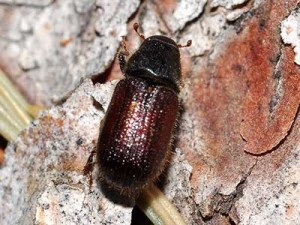
Spruce beetle (Dendroctonus rufipennis) is the most damaging insect in Alaska’s forests. This native insect is always present in our spruce forests and has a notorious history for Alaska forest landowners. In times of low populations, spruce beetle favors large diameter, wind-thrown, or otherwise damaged spruce trees. Spruce beetle is capable of killing otherwise healthy spruce, though, when populations are high, and outbreaks can cause extensive spruce mortality on the landscape. Southcentral Alaska has been experiencing a spruce beetle outbreak since around 2016, which has impacted at least 1.6 million acres. And long-time residents may remember the spruce beetle outbreak in the 1990s, which peaked in 1996 and tapered off in the early 2000s. Spruce beetle outbreaks are less common in the Interior but can occur.
The Division of Forestry & Fire Protection and our cooperators monitor for and have several ongoing projects related to the spruce beetle. These projects include both aerial and ground-based efforts, the status of which are summarized yearly in the Forest Health Conditions in Alaska report produced by USDA Forest Service - Forest Health Protection and their partners. Additionally, the University of Alaska Fairbanks Cooperative Extension Service, Division of Forestry & Fire Protection, and USDA Forest Service - Forest Health Protection have partnered to create www.alaskasprucebeetle.org, a one stop shop for Alaska-specific spruce beetle information.
Please refer to the referenced report or www.alaskasprucebeetle.org for more information on spruce beetle.
Spruce Beetles in Firewood
Spruce beetles attack and breed only in spruce and the trees killed by spruce beetles are often used as firewood. During the first winter after infestation both larvae and adult beetles may be present under the bark. Adult beetles may also be under the bark around the base of the tree through the second winter, emerging the following spring. Two years after the attack, beetles have typically left the tree; a two-year life cycle is most common in Southcentral Alaska.
Adult beetles over-wintering under the bark of firewood emerge when warmer weather arrives and seek out new host material, often a valuable landscape tree near the woodpile. By examining spruce logs to be used for firewood, and following the suggestions below, you may be able to avoid spruce beetle infestations in your live standing trees.
Condition of spruce firewood and ways to reduce beetle populations:
Fresh log with green needles when cut; bark peels away from wood smoothly; wood not split.- Store only enough firewood for a single winter’s use.
- Split into stove-size pieces to dry out; stack loosely or separate to allow maximum air circulation.
- Dry wood discourages new spruce beetle attacks.
- De-bark log to eliminate potential beetle habitat.
- Store only enough firewood for a single winter’s use.
- Split into stove-size pieces to dry out; stack loosely or separate to allow maximum air circulation.
- This will dry out the larvae and their food source.
- De-bark log to eliminate larvae and habitat.
- Split and use prior to next spring to kill adult beetles that will emerge at that time.
- Fire-scorch the outer portion of the bark, killing beetles beneath, but keep the bulk of the wood intact (messy, but intact) for future use.
- Consider preventive measures on surrounding live spruce trees.
- Spruce beetles will not attack well-seasoned wood and are normally gone from trees that have been dead for more than a couple years (though beetles and other insects may enter the wood). Old wood, free of spruce beetles, is not a potential spruce beetle infestation source.
For more information:
Alaska Division of Forestry & Fire Protection Forest Health Program
(907) 269-8460
Email
